Looking back a few years to a September 2013 article in ImportCar, we discussed the issues we were seeing with the 2006 and up Volkswagen and Audi direct injection, high-pressure fuel pumps. Beyond the problem with carbon buildup on the intake valves, the pressure regulator would fail, requiring pump replacement. Some of the early ones would even wear away the tappets and damage the cams, requiring camshaft and pump replacement.
Since then, we have seen a couple of other fuel-related issues pointing to the electric in-tank pump that supplies fuel to the mechanical high-pressure pump. Pressure on the low side from the electric pump will vary depending on demand. The engine control module monitors the high-side pressure using a sensor in the fuel rail. If it wants more fuel, it sends a signal to the fuel pump control module and the module increases the voltage output to the in-tank pump, thereby increasing the pressure. If less pressure is needed, the voltage decreases.
It sounds pretty simple, but when a 2009 Audi A4 was towed in the other day, and Code P0087/16471 “Fuel System Rail Pressure Too Low” was found stored in the ECM, it was way too easy for my tech to say, “I bet it needs a new high-pressure pump.” If I were a betting man, he would have lost. It seems that nine times out of 10, it does need a high-pressure pump, but there are other problems that will set that code.
Let’s take a closer look at how that system works, what can go wrong, and how to diagnose it.
The fuel pump control module has five wires (see Photos 1 and 2). Pins 1 and 2 are the power and ground going to the fuel pump.
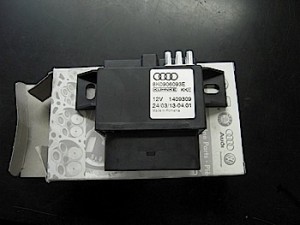
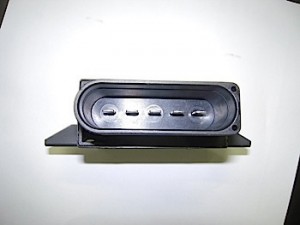
1. Install your fuel gauge inline before the high-pressure pump (see Photo 3), and key-on pressure should jump to about 45 psi. You can supply direct power to these two wires to check the fuel pump operation, and you should get close to 6 bars of pressure/87 psi. Pin 3 is B+ with the key on. This comes from fuse 28 and the ECM power supply relay.
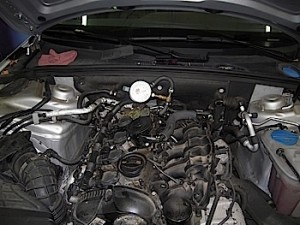
2. If you’re missing the 12 volts at pin 3, check for a blown fuse or faulty relay. The brown wire at pin 4 should be a good ground at all times. Pin 5 is the signal wire from the ECM that tells the module to supply more or less voltage to the fuel pump. It would be rare to see the ECM fail to send the signal to the module, but I’ve heard it can happen.
3. If you have power and ground at pins 3 and 4, and there is no voltage or really low voltage going to the fuel pump, you most likely have a fuel pump control module failure. Be sure to also check for corrosion in the plug.
Our car had no pressure coming out of the in-tank pump. We checked and had power and ground at the pump, so we knew our in-tank pump had failed. The problem could have been that our customer ran his fuel too low, too many times. The parts were readily available, and our customer wanted his car back ASAP, so we got started and replaced the pump.
4. The pump is accessed under the rear seat. Pull up firmly on the front of the seat and then pull the seat out (see Photos 4 and 5).
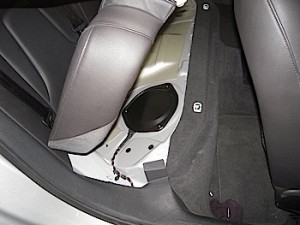
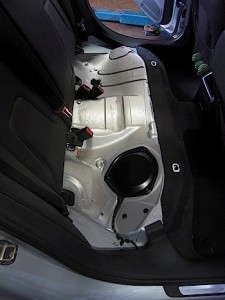
5. Remove the three screws that hold the cover on and you can see the pump. There are two connectors and one fuel line that need to be removed (see Photo 6).
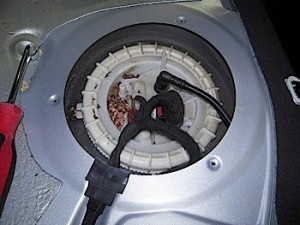
6. When carefully releasing the larger connector, pry up on the retaining clip (see Photo 7) and disconnect the fuel line (see Photo 8).
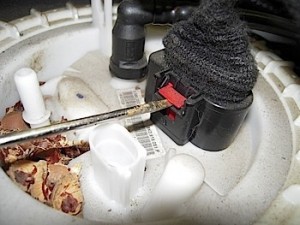
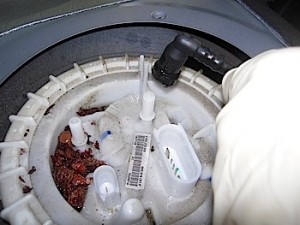
Note: We have a universal fuel pump remover that works well on many different pumps. It’s available from almost any tool salesperson (see Photo 9).
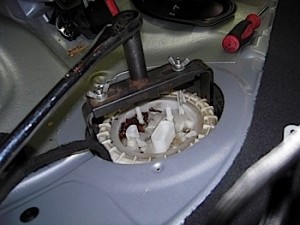
7. Lift the pump up and out very slowly to let as much fuel as possible drain back into the tank, and use plenty of shop rags to soak up any fuel that might spill (see Photo 10).
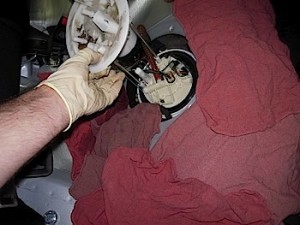
8. There is one plug (see Photo 11) and one fuel line (see Photo 12) to remove, then the pump will come out and the new one can be installed (see Photo 13). The new fuel pump does not come with a new seal, so be sure to order a new seal when ordering the pump.
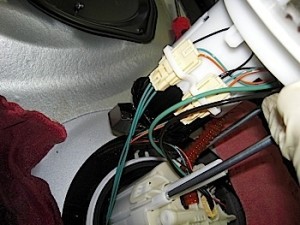
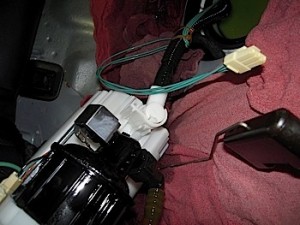
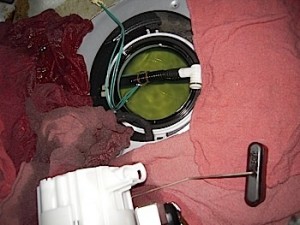
It’s interesting how vehicles and their fuel systems have changed over the years. And just as with any new system that hits the road, there can be a learning curve. When these direct-injection cars started developing misfires, they were subtle at first, and I remember swapping plugs and moving ignition coils to try and diagnose the source of the misfire. We never thought it would be carbon on the intake valves: We put our walnut blaster away years ago.
When I saw my first fuel pump control module fail, I was scratching my head wondering what was wrong with the fuel pressure regulators. It’s time to stop wondering. The operational aspects of many of the new systems are not too complicated, but some of them can be time-consuming to diagnose and repair. That is a good thing, because the only thing we can really sell is our parts and our labor.














